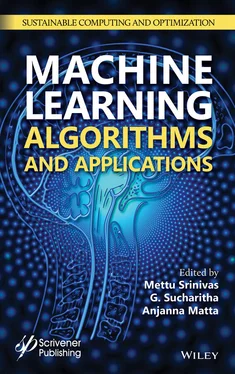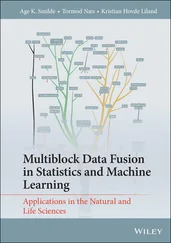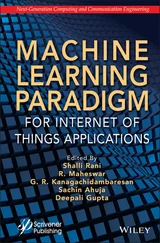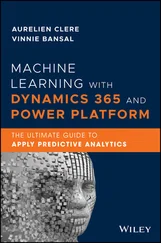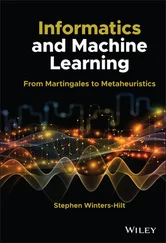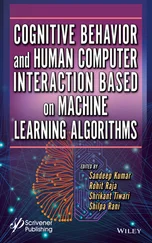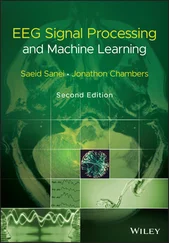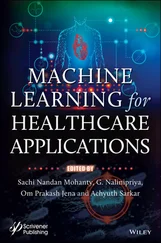15 Chapter 15Figure 15.1 Basic architecture of proposed system.Figure 15.2 Filtering based on linguistic knowledge.Figure 15.3 Contextually similar terms of word “Punctual”.Figure 15.4 Teachers’ features with its importance.Figure 15.5 System performance in teachers’ and laptops’ feedbacks.
16 Chapter 16Figure 16.1 The three-phase proposed approach.Figure 16.2 Phrase extraction sequence.Figure 16.3 Map-reduce framework.Figure 16.4 Sample annotated document.Figure 16.5 Single context CBOW model.Figure 16.6 Generalized CBOW model.
17 Chapter 17Figure 17.1 Flowchart for image anonymization.Figure 17.2 GAN.Figure 17.3 Wasserstein distance.Figure 17.4 Image anonymization to prevent model inversion attack.Figure 17.5 Result over MNIST dataset.Figure 17.6 Comparing privacy gain for WGAN-GP and DCGAN.Figure 17.7 MNIST data distribution: left-hand figure shows anonymized data...
1 Chapter 1 Table 1.1 Range of AQI categories. Table 1.2 Precision, recall, and F1-score. Table 1.3 MAE and RMSE scores for different epochs. Table 1.4 MAE scores for LSTM hyper parameters.
2 Chapter 2 Table 2.1 Specifications of foreground-background (FB) segmentation CNN model. Table 2.2 Specifications of egg location CNN model. Table 2.3 Specification of egg class predicator CNN model. Table 2.4 Performance of the CNN model results on test datasets.
3 Chapter 3 Table 3.1 Statistical information of data collected from Stanford Station. Table 3.2 Effect of various parameters.Table 3.3 Optimum configuration.Table 3.4 Comparison of models.Table 3.5 Coverage of points within the boundary of the regression line.
4 Chapter 4Table 4.1 Performance of baseline ResNets.Table 4.2 Performance of baseline ResNets without bridge connections.Table 4.3 Hyperparameters.Table 4.4 Performance of baseline SE-ResNets.Table 4.5 Performance of proposed model.Table 4.6 Performance improvement from baseline ResNet.Table 4.7 Performance improvement from baseline SE-ResNet.
5 Chapter 5Table 5.1 CNN-based different architectures.Table 5.2 Some CAD references driven by deep learning and medical imaging.
6 Chapter 6Table 6.1 Description about experimental datasets.Table 6.2 Performances of MLFN, RBFN, DTNN, and ensemble approaches with features selection on Australian datasets.Table 6.3 Performances of MLFN, RBFN, DTNN, and ensemble approaches with features selection on German-categorical datasets.Table 6.4 Performances of MLFN, RBFN, DTNN, and ensemble approaches with features selection on Japanese datasets.Table 6.5 Performances of MLFN, RBFN, DTNN, and ensemble approaches with features selection on German-numerical datasets.
7 Chapter 7Table 7.1 Comparison based on varying block size.
8 Chapter 8Table 8.1 Classes present in MIT-BIH database with their percentage.Table 8.2 XGBoost model performance for heartbeat classification using MIT-BIH arrhythmia dataset with train-test ratio 60:40.Table 8.3 XGBoost model performance for heartbeat classification using MIT-BIH arrhythmia dataset with train-test ratio 50:50.Table 8.4 XGBoost model performance for heartbeat classification using MIT-BIH arrhythmia dataset with train-test ratio 70:30.Table 8.5 XGBoost model performance for heartbeat classification using MIT-BIH arrhythmia dataset with train-test ratio 80:20.Table 8.6 XGBoost model performance for heartbeat classification using MIT-BIH arrhythmia dataset with train-test ratio 90:10.Table 8.7 Comparison of the overall accuracy achieved by the XGBoost and AdaBoost classifiers using different traintest ratios of the MIT-BIH arrhythmia database.Table 8.8 Comparison of classification accuracy of proposed work and other state-of-the-art techniques.
9 Chapter 9Table 9.1 Result for prostate cancer data.Table 9.2 Result for DLBCL data.Table 9.3 Result for child all data.Table 9.4 Result for gastric cancer data.Table 9.5 Result for lymphoma and leukemia.
10 Chapter 10Table 10.1 Optimal parameters for 2D Gabor.Table 10.2 EER (%) values using different channels of the VW images.Table 10.3 EER (%) values using feature-level fusion (OR and AND).Table 10.4 EER (%) values using score-level fusion.
11 Chapter 12Table 12.1 The percentage of each class of fingerprints...Table 12.2 The proposed CNN architecture.Table 12.3 Distribution of the images in the training set.Table 12.4 Distribution of the images in the testing set.Table 12.5 Model performance evaluation.Table 12.6 Comparison of the classification accuracies.
12 Chapter 13Table 13.1 Performance (%) of the CNN classification method on FER 2013 datasets.Table 13.2 Performance (%) of the different features with SVM classification method on FER 2013 datasets.Table 13.3 Fusion of CNN, landmark, and HoG features with SVM classification accuracy results.
13 Chapter 14Table 14.1 Results obtained using pre-trained networks.Table 14.2 Results obtained using AnimNet network.
14 Chapter 15Table 15.1 Most strongly and weakly sentiment associated words in teachers’ feedbacks.Table 15.2 Most strongly and weakly sentiment associated words in laptops’ feedbacks.Table 15.3 Estimation of overall sentiment score of an item.Table 15.4 Summary of results accomplished by different important modules/steps.
15 Chapter 16Table 16.1 Parameter details and their values.Table 16.2 Sample candidate phrases extracted from corpus.Table 16.3 Sample phrases and their embedding with similarity score.Table 16.4 Sample words and their embedding with similarity score.
16 Chapter 17Table 17.1 Laplace noise mechanism.Table 17.2 Gaussian noise mechanism.
1 Cover
2 Table of Contents
3 Title Page
4 Copyright
5 Acknowledgments
6 Preface
7 Begin Reading
8 Index
9 End User License Agreement
1 v
2 ii
3 iii
4 iv
5 xv
6 xvii
7 1
8 3
9 4
10 5
11 6
12 7
13 8
14 9
15 10
16 11
17 12
18 13
19 14
20 15
21 16
22 17
23 18
24 19
25 20
26 21
27 22
28 23
29 24
30 25
31 26
32 27
33 28
34 29
35 30
36 31
37 32
38 33
39 34
40 35
41 36
42 37
43 38
44 39
45 41
46 42
47 43
48 44
49 45
50 46
51 47
52 48
53 49
54 50
55 51
56 52
57 53
58 54
59 55
60 56
61 57
62 58
63 59
64 61
65 62
66 63
67 64
68 65
69 66
70 67
71 68
72 69
73 70
74 71
75 72
76 73
77 74
78 75
79 77
80 78
81 79
82 80
83 81
84 82
85 83
86 84
87 85
88 86
89 87
90 88
91 89
92 90
93 91
94 92
95 93
96 94
97 95
98 96
99 97
100 98
101 99
102 100
103 101
104 102
105 103
106 104
107 105
108 106
109 107
110 108
111 109
112 110
113 111
114 112
115 113
116 114
117 115
118 117
119 118
120 119
121 120
122 121
123 122
124 123
125 124
126 125
127 126
128 127
129 128
130 129
131 130
132 131
133 132
134 133
135 134
136 135
137 136
138 137
139 138
140 139
141 140
142 141
143 143
144 144
145 145
146 146
147 147
148 148
149 149
150 150
151 151
152 152
153 153
154 154
155 155
156 156
157 157
158 159
159 160
160 161
161 162
162 163
163 164
Читать дальше
